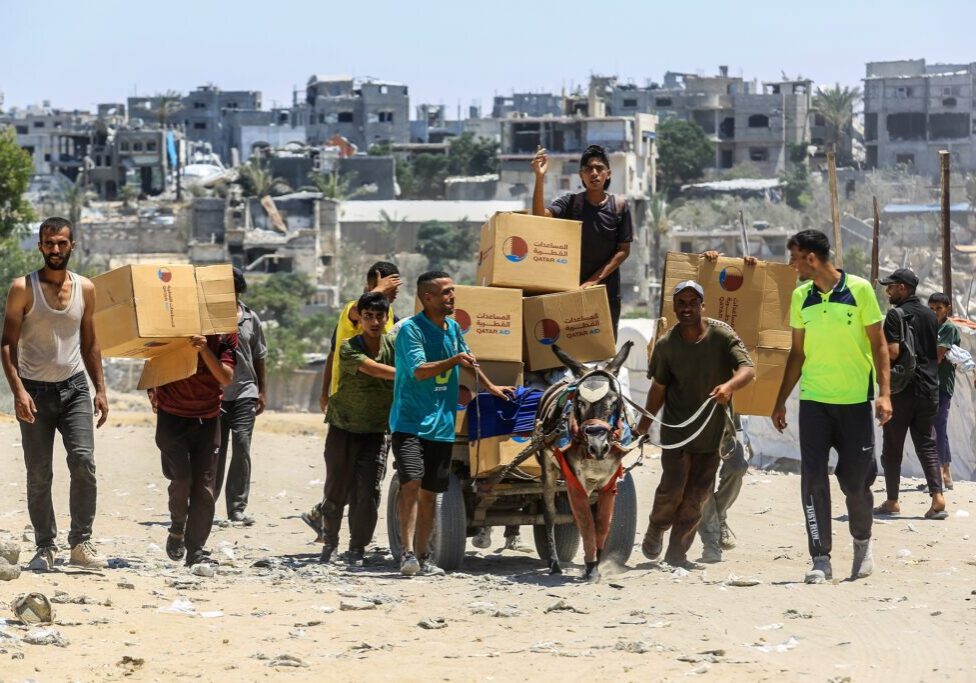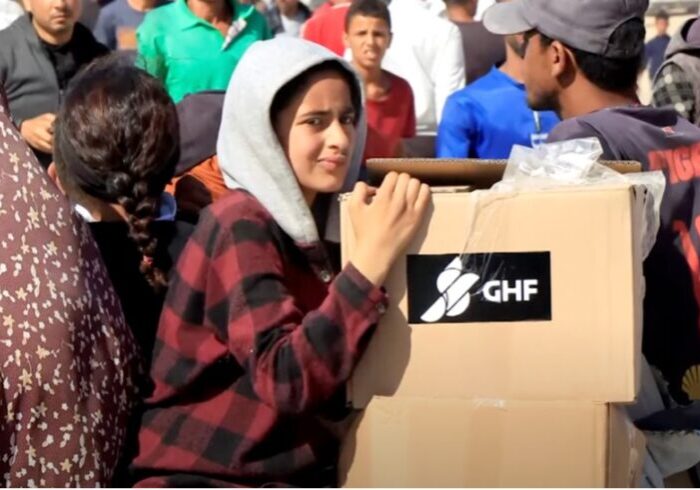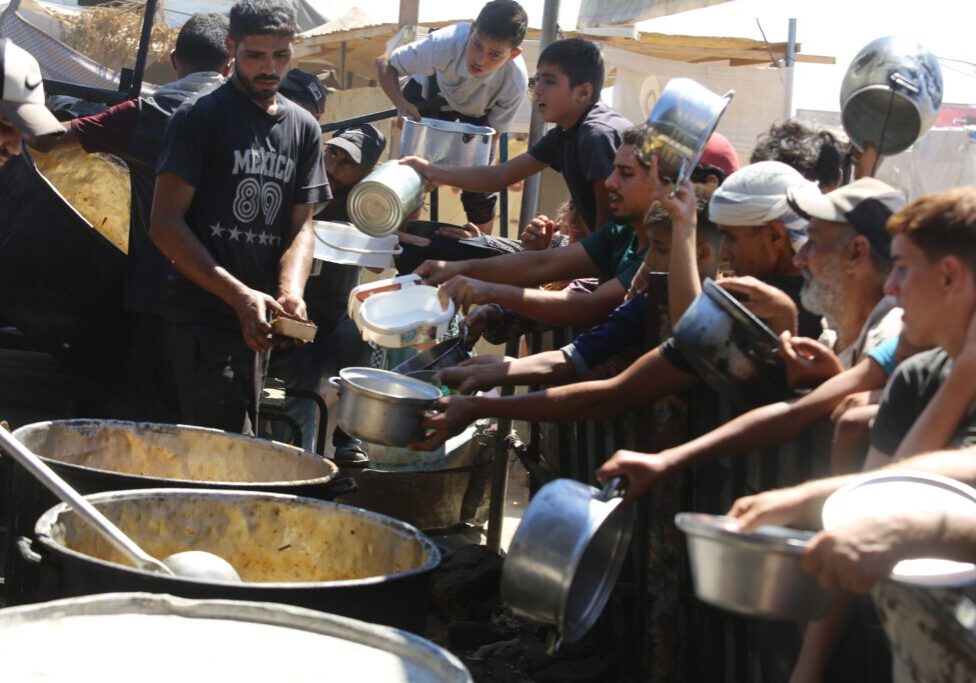Australia/Israel Review
Essay: The Great Refugee Trap
Nov 28, 2012 | Nitza Nachmias

How UNRWA became an obstacle to peace
Nitza Nachmias
The twentieth century experienced some of the worst instances of population displacement in history: the 15 million ethnic Germans forced out of their homes in Eastern Europe after World War II; the millions of Muslims and Hindus fleeing the newly established states of India and Pakistan during the partition of the Indian subcontinent in 1947; the millions of Armenians, Greeks, Turks, Finns, Bulgarians, Jews, and Kurds, among others, driven from their lands and resettled elsewhere.
By contrast, the 600,000 Arabs who fled their homes in mandatory Palestine and the nascent state of Israel during the 1947-48 war have been kept in squalid camps for decades by their Arab hosts as a means of derogating Israel in the eyes of the West and arousing pan-Arab sentiments. And as if to add insult to injury, the UN Relief and Work Agency for Palestine Refugees in the Near East (UNRWA), established in December 1949 as a temporary means for relieving the plight of the newly-displaced refugees, has transformed into a permanent organisation that has substantially exacerbated the problem whose resolution it was supposed to facilitate.
Between Repatriation and Resettlement
The idea underlying the establishment of UNRWA was that “assistance for the relief of the Palestine refugees is necessary to prevent conditions of starvation and distress among them and to further conditions of peace and stability.” Yet it was clear from the outset that these “constructive measures” were of a temporary nature and that “direct relief should be terminated not later than 31 December 1950 unless otherwise determined by the General Assembly.”
Within a year, however, it had become evident that UNRWA had no intention of folding up. Based on its operational report, on December 2, 1950, the General Assembly passed Resolution 393 (V), which asserted “that direct relief cannot be terminated as provided in paragraph 6 of resolution 302 (IV)” and recommended that UNRWA’s activities be continued “in preparation for the time when international assistance is no longer available, and for the realisation of conditions of peace and stability in the area.”
The solution to the refugee problem that UNRWA’s establishment was supposed to facilitate had been outlined by General Assembly Resolution 194 of December 11, 1948, which envisaged the repatriation of the refugees and/or their resettlement in their host countries as part of a comprehensive peace settlement to be mediated by a soon-to-be-established three-member Conciliation Committee for Palestine (UNCCP). In line with this outlook, Resolution 393 instructed the establishment of a US$30 million “reintegration fund which shall be utilised for projects requested by any government in the Near East and approved by the Agency for the permanent re-establishment of refugees and their removal from relief.” This sum was increased in January 26, 1952, to US$100 million for the fiscal year 1952-53.
Tasked by Resolution 194 with facilitating “the repatriation, resettlement, and economic and social rehabilitation of the refugees and the payment of compensation,” UNCCP suggested shifting funds assigned for compensation to resettlement because “when the time comes to pay compensation, it is to be hoped that a large number of the refugees will already have been resettled by UNRWA.” This was also the hope of UN Secretary-General Trygve Lie, who said: “The refugees will lead an independent life in countries which have given them shelter… the refugees will no longer be maintained by an international organisation… They will… provide for their own needs and those of their families.”
In a Jerusalem meeting on February 6, 1951, Sir Henry Knight, a member of UNRWA’s Advisory Commission, reported some good news: “The prospects in regards to reintegration were not bad,” he said. “Jordan seemed ready to accept a certain number of refugees; Egypt had already proposed a programme of public works, which more or less constituted a commitment on her part, and Mr. Tacla had implied that Lebanon would accept for resettlement 20,000 to 25,000 refugees of Lebanese origin.”
The overall plan was to offer the Arab governments vast resources and engage international experts in initiating sustainable agricultural projects that would change the economies of these countries while simultaneously absorbing the refugees. Because Syria, Jordan, and Egypt were in dire economic straits, UNCCP and UNRWA believed that they would ultimately accept the UN money that came with the programs and resettle the refugees.
From the Israeli side, there was also promising news. As early as the Lausanne Peace Conference (April-September 1949), Israeli negotiators had “declared that if the Gaza area were incorporated in the state of Israel, its government would be prepared to accept as citizens of Israel the entire Arab population of the area, both inhabitants and refugees, on the understanding that resettlement of the refugees in Israeli territory would be subject to such international aid as would be available to refugee resettlement in general.”
The Israeli proposal was rejected by the Egyptian Government, which demanded that all the refugees in Gaza be allowed to return to their villages in southern Israel.
A Drawing Board for Resettlement Plans
By the early 1950s, it became increasingly clear that repatriation was no longer an option. John B. Blandford, Chairman of UNRWA’s Advisory Commission, acknowledged this in a confidential memo: “There is probably common agreement that there is no gain for either of our efforts in fanning anew the fires and hopes of repatriation … It would seem desirable that the refugees be fully and promptly informed.” This left resettlement as the only possible solution.
On January 26, 1952, the General Assembly passed Resolution 513 (VI) allocating “the expenditure of US $50 million for relief and $200 million for reintegration … to be carried over the period of approximately three years starting as of 1 July 1951.” The resolution asked UNRWA to “explore with the governments concerned the desirability and practicability of transferring administration of relief to those governments at the earliest possible date.” Later that year, Blandford asked for an additional US$30 million for reintegration projects as a means to reduce UNRWA’s budget for relief.
To a limited extent, the constructive aims of the resolution were accepted. Egypt offered area in the Sinai for 10,000 refugee families if water could be found and if there was no prejudice to refugee interests with regards to repatriation or compensation. Jordan also agreed to the use of the fund for small projects with similar political qualifications. Soon, the first constructive steps were taken; out of these initial operations came knowledge of the area, surveys, irrigation plans, economic planning experience, and some progress on the ground.
UN Secretary-General Lie maintained his optimism: “The Arab States would have a change of opinion, and they would recognise the inevitability of reintegration of refugees elsewhere than in Israel.” Resettlement seemed most logical and natural in Jordan, which in 1950, annexed the territories which subsequently became the West Bank where most of the refugees were based. In 1952, the Jordanian Constitution stipulated that the refugees were Jordanian citizens by law. In stark contrast, the rest of the Arab states refused to grant citizenship to refugees on the pretext of preserving their “right of return” to Palestine.
The US Government was also involved in the resettlement plans. President Truman’s International Development Advisory Board worked on resettlement options and concluded that “under proper development, Iraq alone could absorb an Arab refugee population of 750,000 people.” The General Assembly increased the resettlement fund from US$250 million to US$293 million.
With this impressive budget in hand, UNRWA drafted resettlement plans based on the principle that the projects would be carried out by the refugees, and this would, in addition, solve the problem of unemployment. UNRWA also prepared training programs for them. The reintegration fund would also give loans and grants to refugees to enable them to establish small enterprises, would build houses near their employment, establish rural farms where land was available for cultivation, and construct irrigation works and access roads.
With the July 1952 Free Officers’ putsch in Egypt and the Soviet Union’s assertive moves into the Middle East, Washington began to take more of an interest in greater progress on this front. Eisenhower’s Secretary of State John Foster Dulles felt his first priority was to convince the Arab world of Washington’s evenhandedness and suggested resettlement of the refugees should be divided between Israel and the Arab states.
Eisenhower appointed a team of experts, headed by Ambassador Eric Johnston, which developed the “Jordan Valley Unified Water Plan” (the “Johnston Plan”) for the resettlement of thousands of refugee families. Though the plan was rejected by the Arab League, both Israel and Jordan were eager to implement their respective components, resulting in the establishment of Israel’s National Water Carrier and Jordan’s East Ghor Main Canal (today the “King Abdullah Canal”) project – but not in a durable solution to the Palestinian refugee problem.
Dashed Dreams
Before long, UNCCP and UNRWA reports lamented the slow progress of resettlement plans on the one hand and the waning prospects of repatriation on the other.
For the most part, resettlement options in the Arab host countries went from poor to nonexistent. Keeping the 200,000-250,000 Palestinian refugees in harsh conditions in the Gaza Strip, the Egyptian Government refused to grant them citizenship or to settle them elsewhere in the country on the pretext that “Egypt was densely populated and unable to extend substantially the area of its arable land.” Similarly, the Lebanese Government refused to integrate the 100,000 refugees into Lebanese society because it did “not feel that there are opportunities for refugees to become self-supporting.”
Syria was another disappointment. In 1950-52 there were hopes for a successful resettlement of some 80,000 refugees in the country, and UNRWA initiated the construction of housing projects in Damascus. However, the Syrian Government rejected UNRWA’s pilot project proposals and refused to make state domain land available for the permanent resettlement of refugees.
The only exception to this rejectionist pattern was Jordan where the government took legal and social steps to integrate the refugees into society. King Abdullah’s goals were less than altruistic; he wished to expand his kingdom through annexation of what would come to be known as the West Bank as well as to reap a windfall of financial and technical assistance. As early as July 1949, the Jordanians informed UNCCP and Israel of their intention to resettle 200,000 refugees in return for substantial financial support. Two years later, Jordan and UNRWA signed an agreement “for Palestinian refugees in the Near East,” and the Hashemite Kingdom was promised generous loans and grants “with a view to raising the general standard of living of all inhabitants including refugees.” In cooperation with UNRWA, the Jordanian Government completed a 200-unit housing project for refugees, a large undertaking by a development bank with approved capital of 400,000 Jordanian dinars provided by UNRWA; some small training projects were also expanded into a US$1 million vocational program. The assassination of King Abdullah on July 20, 1951 made his more ambitious plans to resettle all the refugees who had fled to the West Bank and Jordan quite difficult to achieve.
The Failure of Early Resettlement Plans
Several major obstacles hindered the execution of the resettlement plans. As noted above, the Arab League and the Arab governments adamantly objected to resettlement despite the offer of substantial economic incentives, showing total indifference to the suffering of the Palestinians. Instead, the Arab League demanded repatriation of all refugees to their original homes in Israel.
To former UNRWA official Sir Alexander Galloway, this conduct proved that the “Arab States do not want to solve the refugee problem. They want to keep it as an open sore, as an affront to the United Nations and as a weapon against Israel. Arab leaders don’t give a damn whether the refugees live or die.”
Strikingly, a 1961 UNCCP report revealed that it was Israel that apparently made good faith efforts to ameliorate the refugee situation. After detailing the lost opportunities for resettlement resulting from failed negotiations with Egypt, Saudi Arabia, Jordan, Iraq, Syria and Lebanon, the report testifies that alongside the previously mentioned offer vis-à-vis Gaza, “Ben-Gurion did not exclude the possibility of accepting for repatriation a limited number of Arab refugees, but he made it clear … that a real solution of the refugee problem lay in the resettlement of the refugees in Arab states.”
With prospects for resettlement frozen, UNRWA abandoned those efforts and became a giant service-providing bureaucracy. In 1952, its director stated that it was “the largest food purchasing organisation in the entire Near East.” The organisation’s budget for relief increased from US$27 million in 1952 to almost US$80 million in just a few years. The major beneficiary of its operations was Jordan, which received additional aid from the United States and Britain. It is, therefore, not surprising that the Arab League saw in UNRWA not only an important asset that could be used against Israel but as a cash-cow to be milked by Arab regimes.
In particular, UNRWA helped the Arab League uphold its strategy of promoting Palestinian statelessness for its own purposes. UNRWA’s continued distribution of refugee-ID cards to refugee descendants thus supported the Arab League’s approach of barring citizenship for Palestinians in the Arab states.
Undoubtedly, UNRWA’s misinterpretation of its original mandate as well as its unprecedented redefinition of “refugee” contributed to the failure of its early resettlement plans. In 1959, Dag Hammarskjöld, the second UN Secretary-General, pointed out that the organisation had adopted a definition of a Palestinian refugee with no legal basis: “UNRWA’s working definition of a person eligible for its services … is not contained in any resolution of the General Assembly but has been stated in annual reports of the director and tacitly approved by the assembly.” It was not until 1982 that UNRWA requested the General Assembly to legalise its longtime misconduct and “to issue identification cards to all Palestine refugees and their descendants, irrespective of whether they are recipients or not of rations and services from the Agency.”
At the end of the 1948 Israeli-Arab war and throughout the 1950s, once it became clear that repatriation was not an option, UNRWA vigorously pursued and indeed succeeded in resettling hundreds of thousands of refugees in Jordan, Gaza, and the West Bank. However, large-scale plans that would have resolved the problem once and for all were not implemented.
Several factors contributed to this failure. To begin with, the US$300 million budget approved in 1951 was insufficient for the extensive economic development schemes. Moreover, the assumption that such complex projects, involving states still not at peace with each other, could be completed in three years was unrealistic as was the belief that supplementary funds would be coming from the host states and neighbouring oil-producing countries. As a result, comprehensive resettlement plans based on vast economic development projects were abandoned in the late 1950s.
A misperception of the ultimate goals of key players played a determining role in this failure. Both UNCCP and UNRWA wrongly assumed that reintegration and resettlement were economic, not political processes. The Arab states thought otherwise and made it clear that resettlement of the refugees outside of Mandate Palestine was a political issue that could be exploited at will. As one Arab UN representative put it, successful resettlement initiatives “would include the supposition that the Palestine problem is, at long last, solved…[T]his solution … is no more than an effort to justify Jewish immigration into Palestine by another immigration of Palestine refugees into the Arab countries.”
Throughout the years, tens of thousands of Palestinian families – over two thirds of the population – have left UNRWA-administered “refugee camps” and resettled in Jordan, the West Bank and in other countries outside of the Middle East. Only a minority of the descendants of the original 1948 families still reside in the camps, mostly in Syria, Lebanon, and Gaza. Yet UNRWA continues to keep these resettled persons on its refugee rolls with its most recent 2010 records showing about five million “refugees” and ignoring the fact that close to three and a half million people are fully resettled. UNRWA reports indicate that less than a million-and-a-half people reside in areas designated as “refugee camps”.
Notwithstanding this fact, UNRWA has created, during its 62 years of operation, a vast bureaucratic network of some 30,000 Palestinian employees with full tenured benefits, who, in turn, provide social services to millions of Arabs regardless of their legal or economic eligibility. Consequently, UNRWA, the Arab host states, and especially the Palestinian Arab beneficiaries have a vested interest in perpetuating the organisation’s operation and keeping alive the fiction of millions of needy Palestinian refugees.
UNRWA’s current operations are neither benevolent nor humanitarian. The agency functions as a “non-territorial government”, perpetuating the false idea that five million Palestinians are still refugees and in need of humanitarian assistance. As such, UNRWA’s existence is harmful to all players involved: Israel is criticised for not resettling the “refugees”, the Palestinian Authority is denied governing its own citizens, and donors give billions to a nonexistent cause, money that should have been used to help genuine refugees in real distress.
UNRWA’s operation has to be phased out gradually and carefully. Within this framework, Egypt, Syria, and Lebanon have to award full citizenship to all the Palestinians who have resided in their territories for generations (Jordan has already done it). UNRWA, with the help of the UN High Commissioner for Refugees, the International Labour Organisation and other international organisations, should transfer all its facilities (schools, medical clinics, etc.), as well as most of its employees to the local governments’ educational and health systems while those donors wishing to continue their support of the Palestinians should negotiate their assistance procedures directly with the relevant Arab governments. Phasing out UNRWA’s operation is vital to the peace process and the stability of the region.
Nitza Nachmias teaches in the Master of Arts Program on Conflict Resolution at Tel Aviv University. © Middle East Quarterly, reprinted by permission, all rights reserved.
Tags: NGOs






